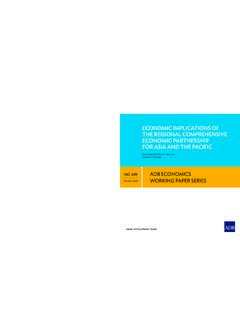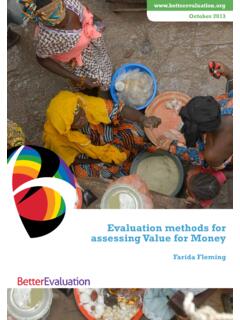Transcription of Impact Typhoons - Asian Development Bank
1 THE Impact OF Typhoons ON. economic ACTIVITY IN THE. PHILIPPINES: EVIDENCE FROM. NIGHTLIGHT INTENSITY. Eric Strobl NO. 589 ADB ECONOMICS. July 2019 working paper series . Asian Development bank . adb economics working paper series The Impact of Typhoons on economic Activity in the Philippines: Evidence from Nightlight Intensity Eric Strobl Eric Strobl is a professor in the Department of Economics and Oeschger Centre for No. 589 | July 2019 Climate Change Research, University of Bern. This paper was prepared as background material for the Asian Development Outlook 2019 theme chapter on Strengthening Disaster Resilience.''. Asian Development bank . Creative Commons Attribution IGO license (CC BY IGO).
2 2019 Asian Development bank 6 ADB Avenue, Mandaluyong City, 1550 Metro Manila, Philippines Tel +63 2 632 4444; Fax +63 2 636 2444. Some rights reserved. Published in 2019. ISSN 2313-6537 (print), 2313-6545 (electronic). Publication Stock No. WPS190278-2. DOI: The views expressed in this publication are those of the authors and do not necessarily reflect the views and policies of the Asian Development bank (ADB) or its Board of Governors or the governments they represent. ADB does not guarantee the accuracy of the data included in this publication and accepts no responsibility for any consequence of their use. The mention of specific companies or products of manufacturers does not imply that they are endorsed or recommended by ADB in preference to others of a similar nature that are not mentioned.
3 By making any designation of or reference to a particular territory or geographic area, or by using the term country . in this document, ADB does not intend to make any judgments as to the legal or other status of any territory or area. This work is available under the Creative Commons Attribution IGO license (CC BY IGO). By using the content of this publication, you agree to be bound by the terms of this license. For attribution, translations, adaptations, and permissions, please read the provisions and terms of use at #openaccess. This CC license does not apply to non-ADB copyright materials in this publication. If the material is attributed to another source, please contact the copyright owner or publisher of that source for permission to reproduce it.
4 ADB cannot be held liable for any claims that arise as a result of your use of the material. Please contact if you have questions or comments with respect to content, or if you wish to obtain copyright permission for your intended use that does not fall within these terms, or for permission to use the ADB logo. Corrigenda to ADB publications may be found at Note: ADB recognizes China as the People's Republic of China and Hong Kong as Hong Kong, China. The adb economics working paper series presents data, information, and/or findings from ongoing research and studies to encourage exchange of ideas and to elicit comment and feedback about Development issues in Asia and the Pacific.
5 Since papers in this series are intended for quick and easy dissemination, the content may or may not be fully edited and may later be modified for final publication. CONTENTS. TABLES AND FIGURES iv ABSTRACT v ABBREVIATIONS vi I. INTRODUCTION 1. II. DATA AND METHODOLOGY 2. A. Nightlights 2. B. Grid Cell Level Typhoon Damages 4. C. Summary Statistics 9. III. ECONOMETRIC ANALYSIS 10. A. Regression Framework 10. B. Econometric Results 10. IV. RISK ANALYSIS 12. A. Extreme Value Analysis 12. B. Threshold Selection 12. C. Results 12. V. CONCLUSIONS 17. REFERENCES 19. TABLES AND FIGURES. TABLES. 1 Summary Statistics 9. 2 Regression Results 10. 3 Impact Return Periods by Region 17.
6 FIGURES. 1 Nightlight Intensity, 2013 3. 2 Total Gross Domestic Product and Total Nightlight Intensity, 1992 2013 4. 3 Total Gross Domestic Product and Total Nightlight Intensity Autonomous Muslim Mindanao, Cordillera, National Capital Region, and Region I 5. 4 Total Gross Domestic Product and Total Nightlight Intensity Regions II, III, IV, and IX 5. 5 Total Gross Domestic Product and Total Nightlight Intensity Regions V, VI, VII, and VIII 6. 6 Total Gross Domestic Product and Total Nightlight Intensity Regions X, XI, XII, and XIII 6. 7 Tropical Storms, 1987 2013 8. 8 Histogram of Tropical Storms, 1987 2013 11. 9 Mean Residual Life Plot: National Losses 13. 10 Quantile Quantile Plot: National Losses 14.
7 11 N-Year Return Period National Losses 15. 12 Regions 16. ABSTRACT. We quantify the economic Impact of Typhoons in the Philippines. To this end we construct a panel data set of local economic activity derived from nightlight intensity satellite images and a cell level measure of typhoon damage constructed from storm track data, a wind field model, and a stylized damage function. Our econometric results reveal that there is a statistically and potentially economically significant, albeit short- lived, Impact of typhoon destruction on local economic activity. Constructing risk profiles from a 60-year historical set of storms suggests that (near) future losses in economic activity for frequent (5-year return period) and rare (50-year return period) events are likely to range from between and Keywords: economic Impact , nightlights, Philippines, Typhoons , wind field model JEL codes: O17, O44, Q54.
8 Typhoons are shown to have a significant negative, but short-lived Impact on local economic activity, as proxied by the intensity of light usage at night. The historical distribution of typhoon storms in the past suggests that frequent storms are likely to cause damages of around 1%, whereas rarer ones will reduce the local economy negatively up to nearly 3% when they strike. I. INTRODUCTION. In all the world, the Philippines is one of the countries most prone to tropical storms, with on average about 6 9 Typhoons making landfall per year since 1970 (Blanc and Strobl 2016). Some scientists predict that their intensity may increase with climate change (Knutson et al.)
9 2010, Emanuel 2013). Moreover, regardless of any increase in intensity or frequency, their effects are likely to be exacerbated by the Philippines' rapidly growing population, particularly along the coast, and its localized environmental degradation (Holden and Marshall 2018). Unfortunately, the few existing studies on the Impact of these storms in the Philippines have largely focused on specific aspects, rather than the economy as a whole. For example, Blanc and Strobl (2016) find that Typhoons have caused losses in rice production of about million tons since 2001, while Anttila-Hughes and Hsiang (2013) find that infant mortality rises by 13% after a typhoon. The purpose of this study is thus to quantify the economic Impact of Typhoons in the Philippines and to use these estimates to predict what expected (near future) impacts may be.
10 Importantly, much of the existing literature on the Impact of tropical cyclones has tended to focus on national or regional effects and the results have been rather However, while insightful, these macroeconomic studies are fairly limited in terms of providing useful information for formulating policies to build resilience. More specifically, tropical storms, as with most natural disasters, are inherently very local in nature and the local Impact will likely be, at least to some extent, aggregated out' if researchers use too broad a regional unit of analysis. As a matter of fact, a number of papers investigate this aggregation problem to measure the Impact of tropical storms, and found that aggregate data tend to underestimate the true Impact of these extreme weather phenomena.











